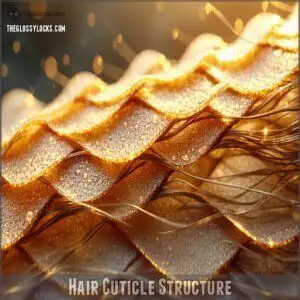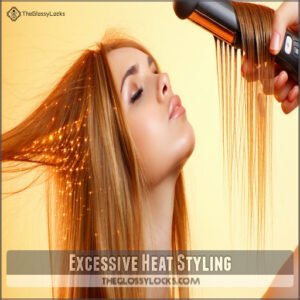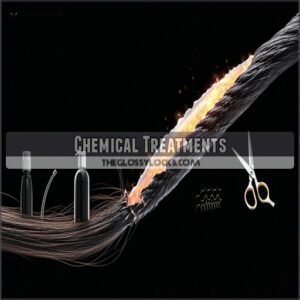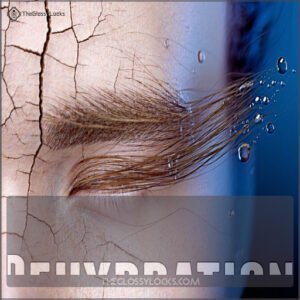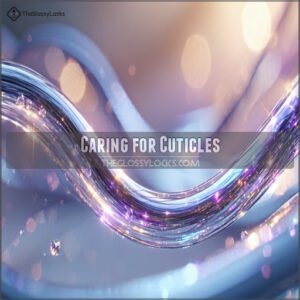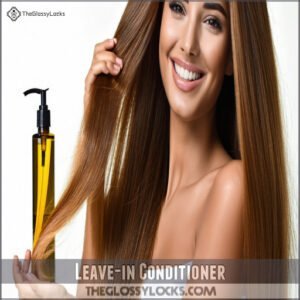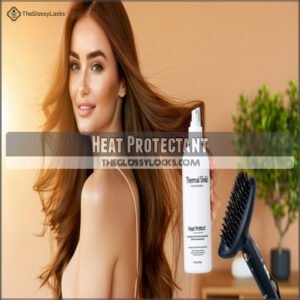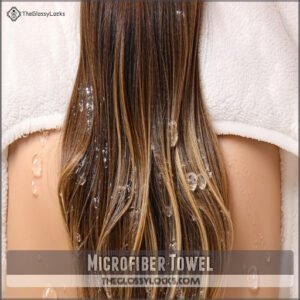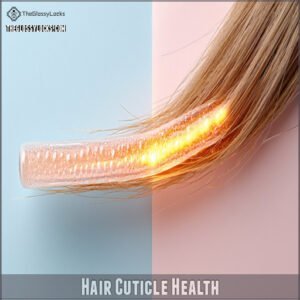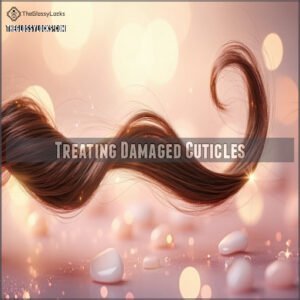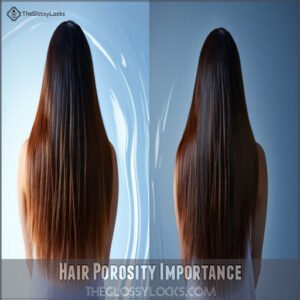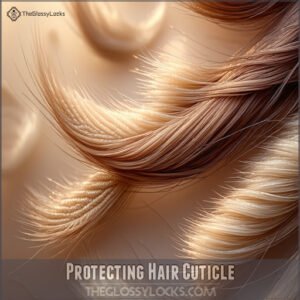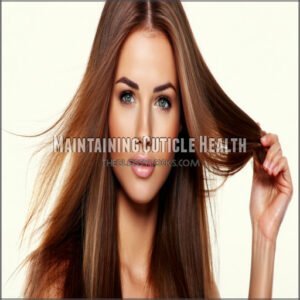This site is supported by our readers. We may earn a commission, at no cost to you, if you purchase through links.
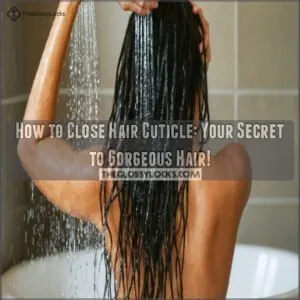 Want to transform your hair from dull to dazzling?
Want to transform your hair from dull to dazzling?
Closing your hair cuticle is your secret weapon.
Start by ditching harsh shampoos and opting for mild, pH-balanced cleansers that gently care for your strands.
Limit heat styling and always use a thermal protectant to shield those delicate scales.
Rinse with cool water to help seal cuticles and lock in moisture.
Leave-in conditioners are your hair’s best friend, smoothing those microscopic protective layers and preventing breakage.
Deep conditioning treatments work overtime to repair damage and restore shine.
With the right technique, you’ll reveal hair that’s not just healthy, but absolutely radiant.
Table Of Contents
- Key Takeaways
- Hair Cuticle Structure
- Hair Cuticle Damage
- Caring for Cuticles
- Sealing Hair Cuticle
- Hair Cuticle Health
- Treating Damaged Cuticles
- Hair Porosity Importance
- Protecting Hair Cuticle
- Maintaining Cuticle Health
- Frequently Asked Questions (FAQs)
- How Often Should I Balance My Hair pH?
- What Are the Benefits of Sealing the Hair Cuticle?
- Is There an Optimal pH Level for Healthy Hair?
- How Can I Protect My Hair from Further Damage?
- Can stress affect hair cuticle health?
- Do genetics play a role in cuticle condition?
- How long does cuticle repair take?
- Are natural remedies effective for cuticles?
- Can diet impact hair cuticle strength?
- Conclusion
Key Takeaways
Here are the key takeaways:
- You’ll want to protect your hair’s cuticle layers by limiting heat styling and always using a thermal protectant, as excessive heat can permanently damage those delicate protective scales.
- Your hair’s pH balance is crucial – choose mild, sulfate-free shampoos and acidifying conditioners that sit around 4.5-5.5 pH to help seal and smooth your cuticle layers.
- You can boost cuticle health by incorporating deep conditioning treatments weekly, using leave-in conditioners, and rinsing with cool water to help close and lock in moisture.
- You’ll transform your hair’s appearance by understanding its porosity, choosing products specifically designed for your hair type, and being gentle during detangling and styling to prevent unnecessary cuticle damage.
Hair Cuticle Structure
Your hair’s cuticle is like a protective shield made of overlapping dead cells, similar to roof tiles guarding your hair’s inner layers.
By understanding how these microscopic scales work, you’ll discover the secret to keeping your hair smooth, shiny, and healthy.
Dead Cells Overlap
Your hair’s secret weapon is its unique cell structure: imagine three to seven layers of dead cells overlapping like protective armor.
These dead cells form the cuticle, creating a robust shield that guards against moisture loss and external damage.
By understanding how these cells work together, you’ll discover the key to healthier, more resilient hair that’s ready to face any challenge with its protective armor.
Scales Forming
Let’s peel back the layers of your hair’s fascinating architecture.
Cuticle layers stack up like protective shingles, creating a robust defense mechanism for your locks.
Here’s how these scales form:
- Dead cells interlock precisely
- Scales align in overlapping patterns
- Texture emerges through strategic cell placement
These intricate scale formations determine your hair’s resilience, texture, and overall protective capacity.
Understanding this cellular choreography reveals the secret to healthier, more vibrant hair.
Protecting Hair Shaft
Those shingle-like scales aren’t just for show—they’re your hair’s first line of defense.
Think of the cuticle as a protective armor, guarding against daily wear and tear.
| Protective Feature | Impact on Hair |
|---|---|
| Cuticle Layers | Shields inner hair structure |
| Flat Positioning | Prevents moisture loss |
| Natural Barrier | Reduces hair breakage |
| Smooth Surface | Enhances hair shine |
Maintaining this robust shield means understanding how to seal and strengthen your hair’s natural defense system.
Hair Cuticle Damage
You’ve probably noticed your hair looking dull, frizzy, or damaged without understanding why.
Excessive heat styling, chemical treatments, environmental factors, and dehydration can wreak havoc on your hair’s protective cuticle, leaving your locks vulnerable and lifeless, due to the impact of these factors on the hair’s overall health, particularly the protective cuticle.
Excessive Heat Styling
Protecting your hair’s delicate structure starts with understanding heat’s silent assault.
Your styling tools can wreak havoc on those protective cuticle scales, turning luscious locks into a dry, brittle mess.
Here’s how to fight back:
- Lower styling temperatures
- Always use heat protectant
- Check tool’s heat settings
- Dry hair completely first
- Take styling breaks
Understanding and addressing heat damage causes is essential for maintaining healthy hair.
Your hair’s health depends on smart, strategic heat management.
Chemical Treatments
After battling heat’s harsh effects, chemical treatments pose another threat to your hair’s armor.
Relaxers and dyes can crack open your cuticle’s protective shield, leaving strands vulnerable.
Color processing and hair relaxers dramatically elevate pH levels, lifting those delicate scales and exposing your hair’s inner core to potential damage.
Tread carefully with chemical treatments.
Environmental Factors
Mother Nature’s harsh elements can wreak havoc on your hair’s delicate cuticle, exposing it to air pollution, UV radiation, and extreme weather conditions.
Wind, cold temperatures, and humidity disrupt your hair’s protective barrier, causing moisture loss and cuticle damage.
Protect your locks by using leave-in conditioners and minimizing outdoor exposure during harsh environmental challenges.
Dehydration
Wind and heat aren’t your only hair enemies—dehydration’s the silent culprit behind dry scalp and hair breakage.
When your body lacks water, your hair suffers too, and low moisture levels weaken hair cuticle closure, causing brittle strands that snap faster than you’d think.
Drinking water isn’t just a health hack; it’s your hair’s secret weapon for hydration and strength.
Caring for Cuticles
You’ve got the power to transform your hair’s health by understanding and caring for your hair’s cuticles.
By learning how to protect and seal these delicate protective layers, you’ll discover the secret to smoother, shinier, and more resilient hair that looks and feels incredible.
Mild Shampoo
After heat’s harsh assault on your hair, it’s time to fight back with a mild shampoo that’s your cuticle’s best friend.
Sulfate-free formulas gently cleanse without stripping away natural oils, helping to close those frazzled hair cuticles.
Look for nourishing ingredients that balance your scalp and lock in moisture, giving your locks the TLC they desperately need.
Using a sulfate free shampoo can be particularly beneficial in maintaining healthy hair cuticles and overall hair health.
Gentle Detangling
Brush through your locks like a pro by reaching for wide-tooth detangling tools that show your hair cuticle some serious love.
Soft brushes and gentle strokes prevent breakage while keeping delicate strands intact.
Choose hair combs with wide teeth and use light, patient movements from ends to roots, saving your hair’s health one careful stroke at a time, which is a result of using gentle strokes.
Limiting Heat Styling
Every styling device threatens to turn your locks into a brittle battlefield.
Limit your heat styling arsenal by choosing lower temperature settings and investing in quality thermal protection sprays. Your hair cuticle will thank you.
Strategically space out heat styling sessions, allowing your strands recovery time between straightening or curling adventures. Preservation is your ultimate hair health strategy, and it involves being mindful of how often you use heat styling tools to prevent damage, thereby ensuring the long-term health of your hair.
Sealing Hair Cuticle
Want gorgeous, healthy hair that turns heads? Sealing your hair cuticle is the ultimate secret to locking in moisture, preventing damage, and achieving that salon-worthy shine you’ve always dreamed of.
Leave-in Conditioner
Diving into the realm of leave-in conditioners, you’ll discover a game-changing ally for hair cuticle repair.
These magical moisture-locking serums work overtime to smooth, protect, and transform your locks.
From detangling nightmares to frizz reduction, a quality leave-in conditioner becomes your hair’s best defense, sealing cuticles and restoring that coveted shine and softness.
To achieve this, understanding the hair cuticle structure is essential for effective hair care and maintenance.
Heat Protectant
After nourishing your locks with leave-in conditioner, grab your thermal shield!
Heat protectant isn’t just another styling product—it’s your hair’s bodyguard against damage.
Spritz these protective sprays before wielding flat irons or blow dryers to create an invisible barrier.
They’ll help close your hair cuticle, preventing moisture loss and keeping your style looking fierce and fabulous.
Microfiber Towel
After protecting your hair from heat, grab a microfiber towel to seal the deal.
These soft, absorbent heroes gently wrap your hair, minimizing friction and damage.
By reducing rough handling, microfiber towels help close hair cuticles, locking in moisture and preventing frizz.
They’re like a soft hug for your strands, keeping your hair smooth and healthy.
Hair Cuticle Health
Your hair’s health starts with its cuticle, a protective layer that shields each strand like tiny roof tiles.
Understanding how to maintain and close your hair cuticle can transform your locks from frizzy and dull to smooth, shiny, and resilient.
Fish Scale Resemblance
Ever wondered why your hair’s structure looks like a fish’s scaly armor?
Your hair cuticle mimics those underwater scales, with overlapping cells creating a protective shield.
Just like fish scales guard marine life, these intricate layers defend your hair’s inner core.
This fascinating cuticle layering determines your hair’s texture, strength, and overall health.
Closed Cuticles
Think of your hair’s cuticles like a perfect armor, snapping shut to guard against damage.
Closed cuticles are your hair’s superhero shield, locking in shine and smoothness.
When these microscopic scales lie flat, you’re winning the battle against frizz, guaranteeing hair that looks healthy, vibrant, and totally Instagram-worthy.
Your secret weapon? Precision hair care techniques. Using an apple cider vinegar treatment can help achieve this by closing the hair cuticle layer, resulting in shiny and healthy hair.
Moisture Retention
Most hair care struggles stem from moisture retention challenges.
Your hair’s health hinges on mastering hydration methods that seal and protect.
- Water absorption impacts cuticle repair
- Balanced moisture prevents breakage
- Strategic hydrators restore hair’s natural shield
- Cuticle sealing treatments lock in wellness
- Targeted hair moisturizing techniques transform texture
Close that cuticle, reveal your hair’s natural potential.
Treating Damaged Cuticles
If you’ve noticed your hair looking dull, frizzy, or feeling rough, you’re likely dealing with damaged hair cuticles that need immediate attention.
By understanding how to close and protect your hair’s outermost layer, you’ll transform your locks from lackluster to luscious, restoring their natural shine and strength.
Acidifying Conditioners
The cuticle-sealing powerhouse, acidifying conditioners, are your hair’s secret weapon for pH balance and smoothness.
These low-pH heroes work magic by bringing your hair to its ideal state, typically around pH 3.0-4.0.
They flatten those unruly cuticle scales, locking in color and moisture while eliminating static flyaways.
By using these specialized conditioners, you’ll transform frizzy, lifeless locks into a glossy, vibrant mane that practically screams health and liveliness, thanks to the power of pH balance.
Cold Water Rinsing
Consistently rinsing your hair with cold water can be a game-changer for cuticle smoothing and frizz reduction.
Cold water helps close hair cuticle layers, sealing in moisture and creating a protective barrier against damage.
By lowering the water temperature at the end of your shower, you’ll enhance hair hydration and minimize cuticle lifting.
This simple rinsing technique locks in your hair’s natural shine, preventing moisture loss and keeping those strands looking sleek and healthy, which is a result of effective cuticle smoothing.
Hair Porosity Importance
Understanding your hair’s porosity is like having a secret map to gorgeous, healthy locks.
By knowing whether you’ve got high or low porosity hair, you’ll discover the perfect moisture strategy that’ll transform your hair from lackluster to legendary.
High Porosity Hair
After battling damaged cuticles, you’ll want to understand high porosity hair‘s wild ride.
Your locks absorb moisture like a sponge and dry faster than a desert wind, often breaking easier than a cheap friendship bracelet.
Prone to frizz and quick absorption, this hair type screams for a moisture balance makeover.
A simple porosity test can reveal everything – just drop a clean hair strand in water and watch how it behaves.
Your genetic blueprint or past chemical treatments might be the culprit behind this thirsty hair situation.
Low Porosity Hair
If high porosity hair’s quick-drying drama left you frustrated, low porosity hair offers a different challenge.
Your hair’s tightly closed cuticles make moisture absorption feel like solving a puzzle. These stubborn strands resist water and products, taking longer to wet and dry.
Hair care tips for low porosity locks? Use lightweight, protein-free products and apply heat when deep conditioning to help moisture penetrate.
Porosity tests can confirm your hair type and guide your cuticle sealing strategy.
Protecting Hair Cuticle
Your hair’s protective shield—the cuticle—is constantly under attack from heat, chemicals, and environmental stressors.
By understanding how to protect and seal your hair’s outermost layer, you’ll discover the secret to maintaining smooth, shiny, and healthy-looking locks.
PH-Balancing Products
If you’re ready to tap into your hair’s potential, pH-balancing products are your secret weapon.
Acidic formulas work magic on your cuticles, helping them snap shut like a well-oiled machine.
- Choose low pH shampoos
- Opt for acidifying conditioners
- Look for gentle hair care solutions
- Select products with balanced pH levels
- Prioritize cuticle-sealing ingredients
Using a pH balancing shampoo can make a significant difference in achieving healthy hair.
Master your hair’s chemistry, and watch those locks transform from frizzy to fabulous.
Cool Water Rinsing
After your shower, transform your hair game with a cool water rinse – a simple yet powerful cuticle-closing technique.
Cold water therapy can help seal your hair’s protective layer, locking in moisture and reducing frizz.
| Technique | Benefits |
|---|---|
| Cold Water Rinse | Smooths Cuticles |
| Moisture Locking | Reduces Frizz |
| Cuticle Closure | Enhances Shine |
| Hair Smoothening | Prevents Damage |
Experiment to find your hair’s perfect cool water sweet spot, and understand how cuticle closure can enhance your hair’s overall health.
Deep Conditioning
When your hair craves serious TLC, deep conditioning becomes your cuticle’s best defense mechanism against damage and dryness.
Your hair health hinges on this game-changing treatment that transforms weak strands into resilient locks.
Regular deep conditioning treatment can substantially improve the overall health and appearance of your hair.
- Restore moisture lost from heat styling
- Repair protein-damaged hair fibers
- Seal cuticles with intensive hydration
- Strengthen hair from root to tip
Maintaining Cuticle Health
Your hair’s cuticle is the unsung hero of your locks, protecting and maintaining its health from root to tip.
By understanding how to care for this delicate layer, you’ll discover the secret to lustrous hair that turns heads and boosts your confidence.
Regular Deep Conditioning
After protecting your cuticles from harsh elements, deep conditioning becomes your hair’s best friend.
Treat your locks to a weekly deep conditioning treatment that seals moisture and repairs damage.
This hair cuticle closing serum works magic, restoring protein, locking in hydration, and giving your strands the TLC they’ve been craving.
Your hair will thank you.
Regular use of a deep conditioning treatment can substantially improve the overall health and appearance of your hair.
Hydrating Products
After deep conditioning, amp up your hair game with targeted hydrating products that’ll make your cuticles sing.
Your hair craves moisture like a desert needs rain.
Check out these game-changers:
- Moisturizing cream with keratin
- Hair serum packed with natural oils
- Deep conditioners targeting specific hair types
- Leave-in products with pH-balancing properties
- Hydrating masks for intense nourishment
Using a sulfate free formula can help maintain color vibrancy while deeply moisturizing each strand.
Seal in that goodness and watch your locks transform with intense nourishment and a sulfate free formula to achieve the best hair care results.
Gentle Hair Care
Gently massaging hair oil can be your first line of defense in close hair cuticle treatments.
Opt for silk pillowcases to reduce friction and prevent breakage.
Use wide-tooth combs for daily gentle detangling, minimizing stress on delicate strands.
Soft water and regular trims keep your hair’s protective barrier strong, ensuring your cuticle sealer for hair works its magic effectively.
Frequently Asked Questions (FAQs)
How Often Should I Balance My Hair pH?
Imagine your locks as a delicate ecosystem needing precise care.
Balance your hair’s pH every 1-2 weeks using apple cider vinegar rinses or pH-balanced products to maintain cuticle health and prevent styling damage.
What Are the Benefits of Sealing the Hair Cuticle?
Sealing your hair cuticle locks in moisture, reduces frizz, and boosts shine.
You’ll notice healthier, more manageable hair that looks vibrant and feels smoother, protecting your strands from daily environmental damage, with healthier being a key outcome.
Is There an Optimal pH Level for Healthy Hair?
You’ll want hair products with a pH between 5-5 to keep your cuticles smooth and sealed.
Slightly acidic formulas help lock in moisture, prevent frizz, and maintain your hair’s natural protective barrier.
How Can I Protect My Hair from Further Damage?
Your hair’s armor needs reinforcing.
Dodge heat damage by using protective sprays, limiting styling tools, and rinsing with cool water.
Deep condition regularly, choose pH-balanced products, and shield those delicate cuticles from harsh treatments to prevent further damage.
Can stress affect hair cuticle health?
Stress can wreak havoc on your hair’s health, triggering hormonal changes that disrupt cuticle integrity.
Elevated cortisol levels may lead to increased hair damage, breakage, and potential long-term structural weakening of your hair’s protective layer, which is related to hormonal changes.
Do genetics play a role in cuticle condition?
Your DNA blueprint whispers secrets of cuticle resilience.
Genetics definitely influence your hair’s natural texture, porosity, and ability to maintain a smooth, protective outer layer, determining how easily your locks absorb and retain moisture.
This can be further understood by realizing that your hair’s characteristics are largely defined by your genetic makeup, which plays a significant role in its natural texture.
How long does cuticle repair take?
Cuticle repair varies by damage severity.
You’ll likely see improvements within 3-6 weeks of consistent gentle treatment, deep conditioning, and avoiding heat styling.
Results depend on your hair’s unique health and care routine.
Are natural remedies effective for cuticles?
Like a secret weapon in your hair care arsenal, natural remedies can indeed be effective for cuticle repair.
Apple cider vinegar rinses, aloe vera, and coconut oil work wonders in sealing and protecting your hair’s delicate layers.
Can diet impact hair cuticle strength?
You’ll boost hair cuticle strength by eating protein-rich foods like eggs, lean meats, and fish.
Vitamins A, C, and E, plus biotin and zinc, help repair and protect your hair’s protective layer from the inside out.
Conclusion
Ultimately, mastering how to close hair cuticle is your ticket to stunning, healthy locks.
Did you know that damaged hair cuticles can reduce hair strength by up to 30%?
By implementing gentle care techniques, pH-balanced products, and protective strategies, you’ll transform your hair’s health.
Your commitment to understanding and nurturing your hair’s delicate structure will reveal shinier, smoother, and more resilient strands that radiate confidence and beauty.
- https://www.lorealparisusa.com/beauty-magazine/hair-care/damaged-hair/what-is-hair-cuticle
- https://longhaircareforums.com/threads/closing-the-cuticle.31222/
- https://www.hcnaturalhair.com/post/is-your-cuticle-layer-closed
- https://www.touchedbyanangelbeautyschool.com/post/how-to-protect-hair-cuticle
- https://www.healthline.com/health/sulfate-in-shampoo

